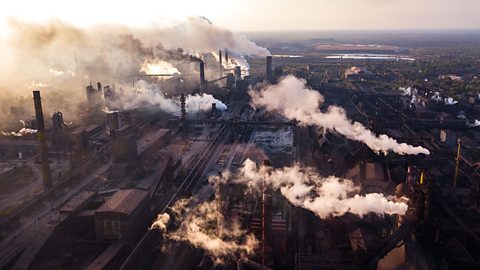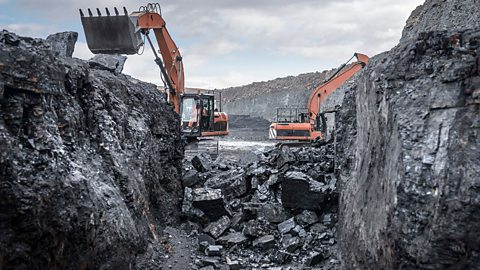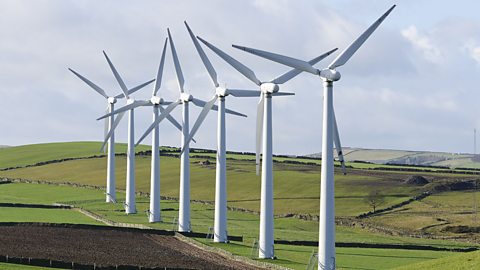What do you know?
What have you used electricity for today?
You might have used electricity to set an alarm clock, or to make breakfast this morning. Electricity powers lighting, most appliances and devices, and sometimes even showers and heating systems. Mobile phones would not work without electricity to charge the battery.
Key points
- Energy powers our homes, industries and transport systems. Some countries have a surplusWhen there is more of something than is needed. An energy surplus means there is more than enough to go around. of energy and others have a deficitWhen there is not enough of something to meet a need. A deficit of something means there is not enough of it to go around.. Energy is traded to even this out.
- Energy consumption is increasing globally. The production of electricity from renewableSomething that can be replaced quickly. For example, there is a continuous supply of wind which makes it a renewable form of energy. energy is increasing, but non-renewableA resource that cannot be replaced very quickly and so could eventually run out. For example, oil takes millions of years to form and so we cannot replace it as quickly as we are using it. fossil fuels still make up most of the energy we use.
- There are advantages and disadvantages of renewable and non-renewable energy resources.
What is energy consumption?

Energy powers buildings, industryOften refers to factories, but can mean any form of employment that makes money., and transport systems. This is often electricityA form of energy used to power buildings and some vehicles. It is delivered by cables and used through plug sockets and light fittings. but can also be fuelSomething that is burned to produce power. For example, wood is a fuel as it can be burned to produce heat. like wood and petroleumA liquid fuel that can be used to make petrol, paraffin, and diesel..
Energy use is often measured per capitaAn average amount of something used to mean per person in a country. For example, adding up a countryās total fuel use and dividing it by the number of people in that country gives energy use per capita.. Iceland, Canada, the United States and wealthier nations in the Middle East are amongst the highest consumerSomeone who uses something. For example, energy consumers use energy. of energy per capita. Iceland is able to exploitTo make use of something and benefit from it, for example natural resources to generate electricity. geothermal powerThe generation of electricity using heat from within the Earth. and many Middle Eastern countries have large reserves of oil. Many oil producing countries are also large consumers of oil. It is usually cheaper and more reliable for a country to use their own energy reserves, rather than import resources from elsewhere. Bangladesh, Burkina Faso and French Guiana are amongst the lowest consumers of energy per capita. In Burkina Faso, around 20 per cent of people don't have access to electricity.

Energy consumption is increasing globally. Non-renewable fossil fuels still make up most of the energy use. New oil fields have been discovered in countries like China and Brazil, which have meant that more fossil fuels are available for use. The production of electricity from renewable energy is increasing. However, only around one-third of the world's electricity is generated using renewables.
Some countries have a surplus of energy and others have a deficit. Energy is tradeWhen countries buy and sell to one another. to even this out. On occasions, energy securityHaving an uninterrupted and affordable energy supply. has led to disputes and even the possibility of conflict between countries. For example, Ethiopiaās Grand Renaissance Dam, which was constructed to generate hydro-electric power (HEP), has led to conflict with Sudan and Egypt. The dam collects water, which reduces the flow of the River Nile into Sudan and Egypt.
Question
Why is per capita a good measure of energy use?
Energy use per capita measures how much energy the average person uses. This is useful when comparing countries of different sizes. A country with a large population may have a greater energy use overall, but a lower energy use when measured per person.
How does electricity reach UK homes?
Electricity is produced when turbineA device that is designed to spin and create an electrical current. are turned. This can be done using things like coal and oil, or wind and waves. As turbines spin, kinetic energyEnergy that results from movement. is converted into an electric current. This produces a voltageAn electrical current, eg the movement of electricity., which is electricity.
transformerA piece of equipment designed to increase or decrease an electrical current. increase the voltage or power. This allows the electricity to travel over long distances.
The electricity is then added to a national gridThe network of high-voltage power lines across the country.. This is a system for managing electricity supplies across a country. It ensures that everyone has access to electricity all of the time.
The electricity arrives at substationA location where an electrical current is passed through a transformer. This can either increase or reduce the current.. These lower the voltage so that it is safe to travel along smaller power lines and into homes.
Electricity enters your home via a meter boxA device that measures how much electricity is being used in a particular home or workplace.. This measures how much electricity you use. It then travels through wires inside the walls to plug switches and light sockets.
Question
What is the national grid and why is it needed?
A national grid shares out all of the electricity generated. It means that an electricity surplus in one part of the country can help to reduce electricity deficit in another. This means everyone has access to electricity all of the time.
Non-renewable energy resources
Non-renewable energy resourceSomething of value due to its usefulness such as food, water or raw materials cannot be replaced and so they will eventually run out. Examples include fossil fuels and nuclear power.

Image caption, Coal - a fossil fuel
Image caption, A nuclear power plant in France
1 of 2
Fossil fuels
fossil fuelA natural fuel such as coal, oil or gas found within the Earthās crust. Fossil fuels are formed from the remains of living organisms. are coal, oil and gas. Burning fossil fuels creates heat, but also releases carbon dioxideA gas that is naturally present in the atmosphere and a greenhouse gas. Trees absorb carbon dioxide and humans breathe it out., which adds to the amount of greenhouse gasThe gases responsible for global warming and climate change - carbon dioxide, methane, nitrous oxide and CFCs (chlorofluorocarbons)..
Advantages:
- Fossil fuels have been used for many years and so they are easy to use.
- They generate large amounts of energy relatively cheaply.
Disadvantages:
- Burning fossil fuels releases carbon dioxide, adding to global warmingAn increase in atmospheric temperatures that can be caused by human activity..
- The UK is dependent on prices set by other countries.
Nuclear power
nuclear powerUsing nuclear reactions to release energy. This can be used to generate electricity. uses uraniumA radioactive substance used as fuel in nuclear power stations. as a fuel.
Advantages:
- Small amounts of uranium produce lots of energy.
- Once up and running, it is cheap to produce electricity.
- Carbon emissions are low.
Disadvantages:
- Accidents involving nuclear power are highly dangerous and can cause loss of life. They can also have long lasting affects.
- The waste from nuclear power is dangerous and so expensive to store.
Renewable energy sources
Renewable energy sources can be replaced quickly. Examples include wind power, hydroelectric power (HEP), and solar energy.

Image caption, Wind power
Wind turbines
Image caption, Hydroelectric power (HEP)
Hydroelectric dam
Image caption, Solar energy
Solar panels
1 of 3
Wind power
Wind power uses turbineA device that is designed to spin and create an electrical current. to harness the power of the wind, which does not generate carbon emissionCarbon gases that are given off by certain activities. For example, burning fossil fuels releases carbon dioxide..
Advantages:
- Wind power does not generate carbon emissions.
- The land beneath turbines can be used for other things.
Disadvantages:
- Wind power can only be used when the wind blows.
- Some people think turbines spoil views and make a noise.
Hydroelectric power (HEP)
hydroelectric power (HEP)A method of generating electricity using the power of water in motion. This is usually done through building a dam and allowing water to flow through part of the dam, where it is turned into electricity. uses damsStrong walls built to hold back water - usually a river. to trap water, which can be used to turn turbines.
Advantages:
- Hydroelectric power does not generate carbon emissions.
- Dams can reduce floodAn overflow of water onto surrounding land after heavy rainfall. risk and water shortages.
Disadvantages:
- Dams are expensive to build.
- Large areas of land are flooded.
Solar energy
Energy released from the Sun is transferred into electricity.
Advantages:
- Solar energy does not generate carbon emissions.
- Solar panels can be placed on houses allowing households to become more energy secure.
Disadvantages:
- Advance costs can be expensive.
- Equipment needs regular maintenance.
- Manufacturing of panels requires fossil fuels to be used.
- Habitats can be damaged with solar panel farms.
Question
Which types of energy do not produce carbon emissions?
Wind power, hydroelectric and solar power do not produce carbon emissions. This is because they do not involve burning any fuel.
Test yourself
Quiz
Play the Planet Planners game! gamePlay the Planet Planners game!
Make decisions for the planet in this KS3 geography game.

More on Environment
Find out more by working through a topic
- count3 of 3

- count1 of 3
